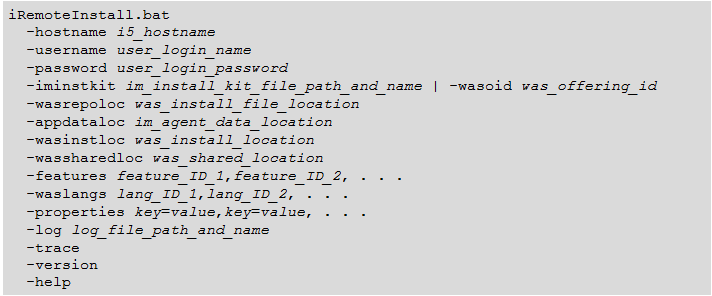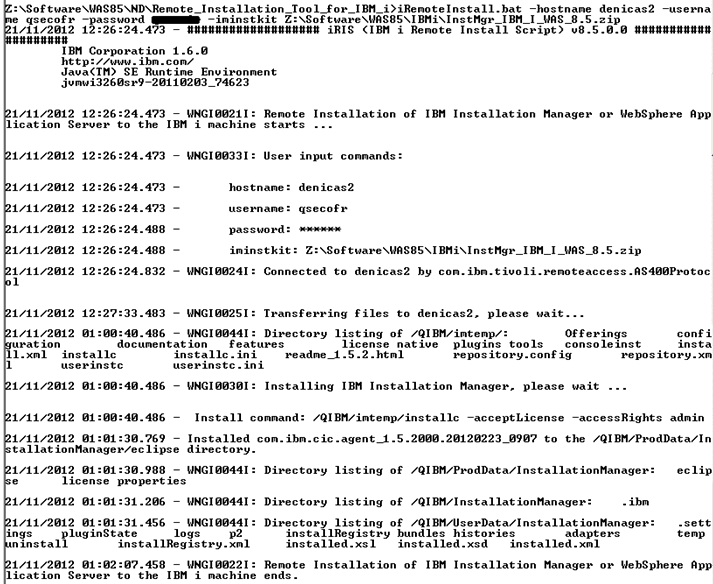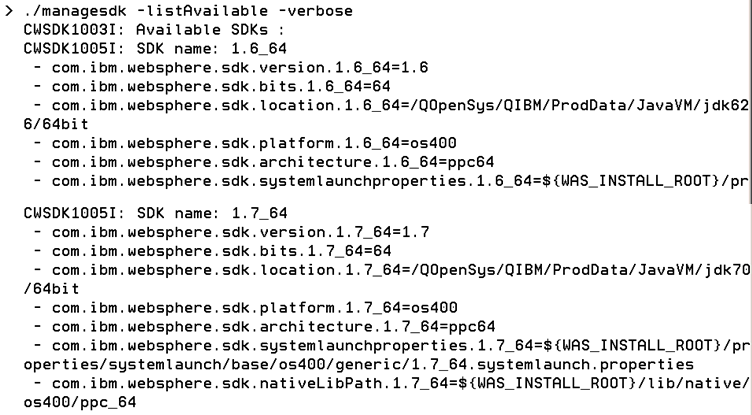3 Installing and Configuring WebSphere 8.5 and 8.5.5
Beginning with JD Edwards EnterpriseOne Tools Release 9.1 Update 2.3, the IBM WebSphere Application Server Release 8.5 is supported.
Beginning with JD Edwards EnterpriseOne Tools Release 9.1 Update 3.3, the IBM WebSphere Application Server Release 8.5.5 is supported. This fix pack can be installed as a new installation or an update.
Relative to WebSphere 7.0, with IBM WebSphere 8.5 the installation procedure has changed dramatically. You will now use the IBM Installation Manager as a central hub to manage the installation process. The IBM Installation Manager is designed to make the installation procedure much simpler and easier than in prior releases.
Additionally IBM WebSphere Application Server 8.5 supports SDK 1.6 as the basic configuration but with SDK 1.7 as an optional configuration.For JD Edwards EnterpriseOne, the implementation requires SDK 1.7 as the default run-time configuration for WebSphere Application Server 8.5. Therefore, after WebSphere Application Server is installed with the basic configuration, you MUST change the default SDK to 1.7.
There are several different methods that you can install WebSphere Application Server 8.5 on IBM i operating system:
-
Response files
-
Command line
-
iRemoteInstall Command
This document focuses on both the Command Line and iRemoteInstall Command methods.
This chapter describes these tasks:
-
Section 3.2, "Installing WebSphere Products using Command Line"
-
Section 3.3, "Installing WebSphere Products using iRemoteInstall Command"
-
Section 3.4, "Installing and Configuring the IBM HTTP server"
-
Section 3.5, "Applying Updates to the WebSphere Application Server 8.5"
-
Section 3.6, "Verifying SDK 7.0 on WebSphere Application Server 8.5"
-
Section 3.7, "Switching to SDK 7.0 on WebSphere Application Server 8.5"
-
Section 3.8, "Creating a New Profile for the WebSphere Application Server"
3.1 Before You Begin
Before you begin the installation of WebSphere 8.5 on IBM i systems, you should perform the steps in this section.
-
All editions of WebSphere Application Server V8.5 use the Installation Manager 1.5.3 to install and maintain the product.
-
Review the installation checklist at the below link and apply any requested PTFs:
-
Download all the required software from the JD Edwards Update Center.
-
Install the required IBM WebSphere SDK Java Technology Edition 7.0. This JDK is available in these versions depending on the bitness of your system:
-
IBM WebSphere SDK 7.0 32 bit (5761-JV1 option 14), PTF SI46212
-
IBM WebSphere SDK 7.0 64 bit (5761-JV1 option 15), PTF SI46211

-
-
The following table lists the IBM i Group PTFs that are included in the WebSphere Application Server Group PTF, along with the versions, that were tested with WebSphere Application Server V85 for IBM i.
| Area | Group PTF Number | Group PTF Level Tested | |
|---|---|---|---|
| WebSphere 8.5 | WebSphere 8.5.5 | ||
| Database | SF99701 | #12 | #24 |
| Java | SF99572 | #7 | #14 |
| IBM HTTP Server | SF99368 | #11 | #21 |
3.2 Installing WebSphere Products using Command Line
This section discusses these topics:
-
Section 3.2.1, "Installing the IBM Installation Manager using the Command Line"
-
Section 3.2.2, "Installing WebSphere Express or Network Deployment using the Command Line"
3.2.1 Installing the IBM Installation Manager using the Command Line
Use this procedure to install the IBM Installation Manager using the command line.
-
Download and expand the Installation Manager assembly (zip file) to your IBM i system. For example:
/home/was85/im -
Run these commands from Qshell:
$ cd /home/was85/im $ umask 022 $ installc -acceptLicense -log ../im.install_log.txtThe IBM Installation Manager is installed to this directory on your IBM i system:
/QIBM/ProdData/InstallataioManager
3.2.2 Installing WebSphere Express or Network Deployment using the Command Line
Caution:
Before you perform this procedure, you must have previously installed the IBM Installation Manager as described in the previous section of this guide entitled: Section 3.2.1, "Installing the IBM Installation Manager using the Command Line".Fix Pack 8.5.5 can be installed as a new installation or an update. For purposes of this procedure, all references are to release 8.5, but you can substitute 8.5.5 where applicable
Use this procedure to install WebSphere Express or Network Deployment using the command line.
-
Expand the WebSphere Application Server zip file into a common directory. After all files are unzipped to a single directory, the directory should look similar to the following:

-
Start Qshell:
$ STRQSH -
Change directory to the location to the tools folder of the Installation Manager. For example:
$ cd /QIBM/ProdData/InstallManager/eclipse/tools -
Enter the following command based on the product you want to install (where the bolded section is the variable that specifies the product):
ND Installations
$ imcl install com.ibm.websphere.ND.v85 -repositories /home/was85 -installationDirectory /QIBM/ProdData/WebSphere/AppServer/V85/ND -sharedResourcesDirectory /QIBM/UserData/InstallationManager/IMShared -acceptLicense -showProgressBASE Installations
$ imcl install com.ibm.websphere.BASE.v85 -repositories /home/was85 -installationDirectory /QIBM/ProdData/WebSphere/AppServer/V85/BASE -sharedResourcesDirectory /QIBM/UserData/InstallationManager/IMShared -acceptLicense -showProgressEXPRESS Installations
$ imcl install com.ibm.websphere.EXPRESS.v85 -repositories /home/was85 -installationDirectory /QIBM/ProdData/WebSphere/AppServer/V85/EXPRESS -sharedResourcesDirectory /QIBM/UserData/InstallationManager/IMShared -acceptLicense -showProgressUpon completion, the IBM i system indicates the product is installed, as shown in the following example for a ND installation:

-
Enter the following command to review the installed products:
imcl listInstalledPackages -longThe below example shows returned results for an IBM i system with WebSphere Express and ND installed.
WebSphere 8.5

WebSphere 8.5.5

3.3 Installing WebSphere Products using iRemoteInstall Command
This section discusses these topics:
-
Section 3.3.2, "Installing the IBM Installation Manager using the iRemoteInstall Command"
-
Section 3.3.3, "Installing WebSphere Express or Network Deployment using the iRemoteInstall Command"
3.3.1 Understanding the iRemoteInstall Command
The iRemoteInstall.bat program is located in this folder in either the ND or Supplement images:
/Remote_Installation_Tool_for_IBM_I
The syntax of the iRemoteInstall command is shown below:

3.3.2 Installing the IBM Installation Manager using the iRemoteInstall Command
Fix Pack 8.5.5 can be installed as a new installation or an update. For purposes of this procedure, all references are to release 8.5, but you can substitute 8.5.5 where applicable.
Use this procedure to install the IBM Installation Manager using the iRemoteInstall command.
Note:
This procedure must be performed from a Microsoft Windows machine.-
On a Microsoft Windows machine, download this Installation Manager zip file:
InstMgr_IBM_I_WAS_8.5.zipNote:
You do not need to unzip this file. -
Download these WebSphere Application Server for Network Deployment (ND) zip files:
WAS_ND_V8.5_1 of 3.zipWAS_ND_V8.5_2 of 3.zipWAS_ND_V8.5_3 of 3.zip -
Unzip the above downloaded files.
-
Locate the
iRemoteInstall.batfile from the WebSphere product directory. For example:Z:\software\ND\Remote_Installation_Tool_for IBM_i -
Open a Microsoft Windows command line window As Administrator.
-
Enter this command to install the IBM Installation Manager:
iRemoteInstall.bat -hostname <your_host> -username <userid> -password <password> -iminstkit <location of the Installation Manager zip file>The following example shows an example of the command and the results of its execution.

3.3.3 Installing WebSphere Express or Network Deployment using the iRemoteInstall Command
Use this procedure to install WebSphere Express or Network Deployment using the the iRemoteInstall command.
-
On a Microsoft Windows machine, download these WebSphere Application Server zip files:
WAS_ND_V8.5_1 of 3.zipWAS_ND_V8.5_2 of 3.zipWAS_ND_V8.5_3 of 3.zip -
Unzip the above downloaded files.
-
Locate the
iRemoteInstall.batfile from the WebSphere product directory. For example:Z:\software\ND\Remote_Installation_Tool_for IBM_i -
Open a Microsoft Windows command line window As Administrator.
-
Enter this command to install the WebSphere Application Server:
iRemoteInstall.bat -hostname <your_host> -username <userid> -password <password> -wasoid ND -wasrepoloc Z:\Software\was85\ND -wasinstloc /QIBM/ProdData/WebSphere/AppServer/V85/NDThe following example shows an example of the command and the results of its execution.

3.3.4 Verify the Installation
You can view the installed products using this command:
./imcl listInstalledPackages -long
You can also verify the installation thru Work with License Program. For example, that program returns results similar to those shown in this example:

3.4 Installing and Configuring the IBM HTTP server
The IBM HTTP Server is installed under the license program 5770DG1. You should apply the required group PTF as listed in the following table:
| Area | Group PTF Number | Group PTF Level Tested |
|---|---|---|
| IBM HTTP Server | SF99368 | #11 |
3.5 Applying Updates to the WebSphere Application Server 8.5
This section discusses these topics:
3.5.1 Applying Updates from the Command Line
After you have installed WebSphere Application Server, you should verify if any updates or iFixes are required.
Product fix packs contain bundled service to bring WebSphere Application Server up to a new product level. Interim fixes provide corrective service for specific known problems. You can use the IBM Installation Manager command-line function to update the product with the fixes that are available for your service level of WebSphere Application Server version 8.5.
Note:
You cannot use the iRemoteInstall command to install a fix pack.Use this procedure to apply updates to the WebSphere Application Server:
-
Download a file that contains the fix pack from Fix Central, and use local updating.
-
Transfer the compressed fix file in binary format to the IBM i systems on which it will be installed.
-
Extract the compressed repository file to a directory on your system.
-
Sign on to the IBM i system with a user profile that has *ALLOBJ and *SECADM special authorities.
-
Stop all servers and applications on the WebSphere Application Server installation that is being updated.
-
On a CL command line, run the STRQSH commands to start the Qshell command shell.
-
Make suer that the umask is set to 022.
-
Change to this directory:
<Installation_manager>/eclipse/tools -
Install the fix pack using this command:
./imcl install <offering_ID_offering_version -repositories <location_of_expanded_files> -installationDirectory <product_installation_locatin> -acceptLicense -
Verify by installation by using this command to list all installed packages:
./imcl listInstalledPackages -log
3.5.2 Applying Updates using the iGSC WebSphere8xScripts Utility
Use this procedure to apply updates to WebSphere Application Server using the iGSC WebSphere8xScripts Utility.
Note:
This utility can also update the IBM Installation ManagerCaution:
In order to install the fix pack updates, you must have the fix pack group PTF loaded on the system.-
Download the iGSC WebSphere8xScripts utility as described below:
-
Create this directory on your system:
/Websphere8xScripts -
Navigate to this IBM download location:
-
Save the
Websphere8xScripts.zipfile into the directory/Websphere8xScriptsyou created in the first step of this procedure. -
Within the directory that you placed the downloaded
.zipfile for the scripts, unzip the files using this command:jar -xvf Websphere8xScripts.zip -
Execute this shell script:
WasInstallMenu.sh

-
-
On WebSphere Application Server Install/Uninstall/Fix Pack Menu, enter the number of the task to perform.
3.6 Verifying SDK 7.0 on WebSphere Application Server 8.5
JD Edwards EnterpriseOne supports WebSphere Application Server 8.5 running with SDK 7.0 only. You must switch the java level after the installation is completed.
Starting with WebSphere Application Server 8.5, SDK 7.0 is supported as an optional feature. The java 1.6 is still the default installation.
Use this procedure to verify the java level:
-
Locate the managesdk command which is located in the bin directory of your profile. For example:
/QIBM/ProdData/WebSphere/AppServer/V85/ND -
Use this command to view the available Java products:
managesdk -listAvailableBelow is an example of the returned results from this command:

Note:
SDK 1.6 is always installed. -
Use this command to view the available Java products with details information:
managesdk -listAvailable -verboseBelow is an example of the returned results from this command:

Note:
SDK 1.6 is always installed.
The following examples demonstrate correct syntax when you run the managesdk command:
managesdk -listAvailable [-verbose]
managesdk -listEnabledProfile -profileName AppSrv01 [-verbose]
managesdk -listEnabledProfileAll [-verbose]
managesdk -enableProfile -profileName AppSrv01 -sdkname 1.7_64 -enableServers
managesdk -enableProfileAll -sdkname 1.7_64 -enableServers
managesdk -getNewProfileDefault [-verbose]
managesdk -setNewProfileDefault -sdkname 1.7_64
managesdk -getCommandDefault [-verbose]
managesdk -setCommandDefault -sdkname 1.7_64
3.7 Switching to SDK 7.0 on WebSphere Application Server 8.5
The section provides examples that demonstrate the sequence of commands to use to:
-
Section 3.7.4, "Set Existing Profile Default to Version 7.0 SDK"
-
Section 3.7.5, "Modify the JD Edwards EnterpriseOne Server Manager Agent with JRE 1.7.0"
3.7.1 List Available SDKs
Issue this command to view a list of available SDK names for the product installation:
./managesdk -listAvailable
The following is an example of the returned results from this command:

3.7.2 Change the Default SDK to Version 7.0 SDK
Issue this command to change the default SDK to Version 7.0 SDK:
./managesdk -setCommandDefault -sdkname 1.7_64
The following is an example of the returned results from this command:

3.7.3 Set New Profile Default to Version 7.0 SDK
Issue this command to change the set the default for new profiles to Version 7.0 SDK:
./managesdk -setNewProfileDefault -sdkname 1.7_64
The following is an example of the returned results from this command:

3.7.4 Set Existing Profile Default to Version 7.0 SDK
Issue this command to change the set the default for existing profiles to Version 7.0 SDK:
./managesdk -enableProfileAll -sdkname 1.7_64 -enableServers
The following is an example of the returned results from this command:

3.7.5 Modify the JD Edwards EnterpriseOne Server Manager Agent with JRE 1.7.0
Use this procedure to modify the Server Manager Agent with JRE 1.7.0:
-
Stop the JD Edwards EnterpriseOne Server Manager Agent.
-
Edit the
runAgentfile to include the location of thejdk70as specified by theJAVA_HOMEsetting. For example:JAVA_HOME=/QOpenSys/QIBM/ProdData/JavaVM/jdk70/64bit -
Save the
runAgentfile. -
Start the JD Edwards EnterpriseOne Server Manager Agent.
3.8 Creating a New Profile for the WebSphere Application Server
Use this procedure to create a new profile for the WebSphere Application Server:
-
On a CL command line, run the STRQSH commands to start the Qshell command shell.
-
Change to this directory:
/QIBM/ProdData/WebSphere/AppServer/V85/ND/bin -
Use the following command to create a profile:
./manageprofiles -create -templatePath /QIBM/ProdData/WebSphere/AppServer/V85/ND/profileTemplates/default
3.9 Manually Generating a Plug-in
Note:
Federated (Clustered) Web Servers. If you are using WebSphere Application Server and running JD Edwards EnterpriseOne as part of a federated (or clustered) web server, you may need to regenerate the WebSphere global plugin configuration after deploying the newest tools release. This is required when new servlets have been added to the tools release you are deploying.To update (regenerate) plugins, refer to the following procedure.
To update (regenerate) and propagate the global web server plugin configuration:
-
Log on to the Deployment Manager Administration Console using the Dmgr01 profile.

-
Expand the Environment node and select Update global Web server plug-in configuration.
-
Review the content in the right-hand pane and note the location of the plug-in file in the description. For example, the description might say:
The global plugin-cfg.xml file is placed in the %was_profile_home%/config/cells directory.
-
Click the OK button.